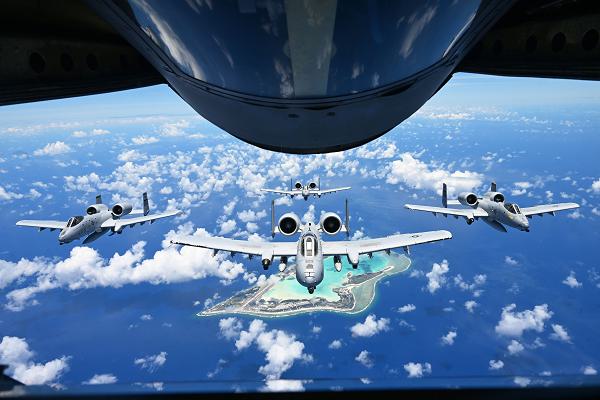
Wake Island. South Pacific. In this photo by Air Force Senior Airman Audree Campbell, A-10 Thunderbolt II aircraft fly in formation over Wake Island, a tiny island with an extremely dark past. During World War II, Wake was the scene of some of the worst atrocities committed by Japanese troops against innocent civilians and POWs.
Wake Island is a coral atoll in the Pacific Ocean located 2,300 miles west of Honolulu and 1,500 miles northeast of Guam. Originally part of Micronesia, the atoll is currently under the administration of the American Department of the Interior. The island is shaped like a crescent with a 4.5-mile reef surrounding a deep-water lagoon. For years prior to the war, Wake was a lonely outpost used mostly by Pan American Airlines as a transit stop for long flights over the Pacific.
The Japanese conducted two amphibious assaults, one on 11 December 1941 (which was rebuffed) and another on 23 December, which led to the Japanese capture of the atoll. As they did elsewhere in the Pacific, the Japanese used the 98 POWs for slave labor and subjected them to inhuman conditions. Many prisoners were placed on a "hell ship" to be transported to a prison in Japan occupied China. Encouraged by the ship’s captain, the POWs were given too little food and water in unsanitary conditions in the ship's holds, and they were systematically beaten and tormented. Five were executed during the voyage.
Meanwhile on Wake Island, an American naval blockade caused the Japanese forces to ration food to point of bare human existence. Fishing, growing vegetables, bird eggs, and rats were important food supplies at this time, and sometimes tens of thousands of rats were eaten to stave off starvation.
In October 1943, the Japanese realized they were likely to lose the war, so they decided to execute the remaining prisoners. POWs were marched into an anti-tank ditch and mowed down by machine gun fire.
When the Japanese garrison surrendered in September 1945, its commander and his lieutenant were tried for war crimes. Both were sentenced to death. The remains of the murdered civilians were exhumed and were reburied at the National Memorial Cemetery of the Pacific, commonly known as Punchbowl Crater, on Honolulu.
Today, Wake Island continues to be a vital player in any future war in the Pacific.


